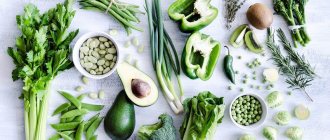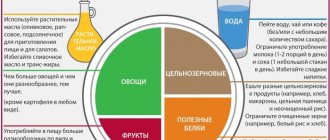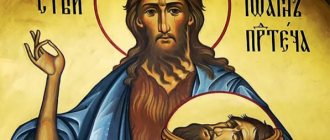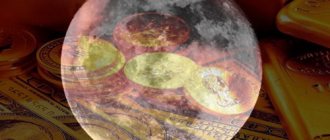So Maslenitsa week has ended, all Orthodox Christians asked each other for forgiveness on Forgiveness Sunday, and on March 2, 2020, Lent before Easter begins. Why on our website about holidays do we suddenly write about posts? Yes, because in our lives everything is very closely connected. Almost every Russian person considers himself Orthodox, loves and honors his traditions. And sometimes, in order to celebrate some great holiday, you need to carefully prepare for it. So, before we talk about the menu by day during the fast before Easter, let's look at what and when fasts are established in the Orthodox tradition.
How to fast during Lent
Any fast is good, but you need to approach it with prudence. Fasting, like overeating, is an excess that does not lead to anything good. After a grueling fast, a person overeats and is no longer able to stop. With overeating, things are simpler; a person can repent, return to a normal lifestyle, and fast correctly. But in the first case there will be no return. An exhausted body will constantly require food.
That is why moderation is one of the main rules during long-term fasting. A person needs to eat exactly as much strength and energy as necessary to maintain vitality. On this occasion, St. Paul said to those who unnecessarily and without permission entered into fasting:
Fasting is not a ceremonial act, not a ritual, it is a sacrament given by the Savior to cleanse the soul. And putting it on display is a sin; it is tantamount to blasphemy against a shrine. There is good advice on this matter given by Isaiah:
These are wonderful words that explain to us that we should not humiliate loved ones with their weakness, do not show your superiority over them.

As for eating lean food in all the rigor of fasting, it’s not so simple. It is necessary to take into account the state of health; desire alone is not enough for this. The Lord does not require a hungry sacrifice from us, he needs a sacrifice of repentance, humility, and forgiveness.
It is also worth considering the main rule, everything is for the good, if after the end of the fast a person can significantly undermine his health, the fast should be postponed.
There are wonderful words on this occasion that explain to us the whole essence of existence, the attitude of the church to fasting as such:
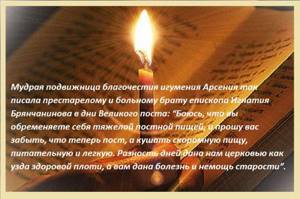
Also, exhausted and sick people should not fast. The Lord needs a feasible sacrifice; only a healthy person can bear it.
Regarding proper nutrition during Lent for all churchgoers, it is worth paying attention to the rules and prohibitions of Lent. Also, when planning the menu, it is worth taking into account the number of weeks, there are seven of them this year. Each one is special and requires attention. To withstand long-term abstinence, to withstand an unequal battle with temptations, you need to prepare. For this purpose , a preparatory period is allocated, which helps a person tune in to the right mood.
Recipes
Considering that after fasting you still need to observe moderation in food and gradually return to your usual diet, it is better not to eat heavy and high-calorie foods on Easter. First of all, the body is unaccustomed to digesting fatty foods. Secondly, you may still be on a diet. In this case, cottage cheese dietary Easter is suitable. According to the recipe, it contains low-fat cottage cheese, a sugar substitute, low-fat sour cream and fermented baked milk instead of cream. It is healthier to eat a small piece of cottage cheese Easter than flour baked goods, which have a high calorie content.
Cottage cheese diet Easter
Ingredients: 300 g low-fat cottage cheese, 100 g 10% sour cream, 100 ml fermented baked milk, 1 tsp. gelatin, sugar substitute, vanillin, honey and dried fruits (preferably goji berries) are taken to taste, since during the cooking process you can taste the curd mass.
Pour hot water over the dried fruits, cut the already softened ones into small pieces. Beat the cottage cheese in a blender or rub through a sieve. Mix cottage cheese, sweetener, fermented baked milk, sour cream and a mixture of dried fruits. Add pre-swollen gelatin (1 tsp) and add honey if the curd mixture is not sweet enough. Place in a silicone Easter mold or simply in a round glass bowl. Place in the refrigerator overnight.
Dietary Easter cake
Ingredients: 4 whites and 2 yolks, 1 tbsp. l. corn starch, 4 tablespoons bran (oat bran, chopped), 5 tablespoons skim milk powder, 1 tsp. baking powder, lemon zest, sweetener, vanillin.
Separate the yolks from the whites. Beat the yolks with sweetener. Beat the whites separately until foamy. Take the zest of one lemon. Mix the beaten yolks, whites and zest. Add all dry ingredients to the liquid part. The dough turns out liquid. Pour it into a paper or silicone mold and place it in the oven at 1800 for 30 minutes. Kulich rises well. It can be left as is or decorated with icing.
Rules of Lent
1. Moderation in food. This is practically one of the main rules of a fasting person. Experienced fasters should eat food at least three times a day in small portions. At the same time, drink plenty of fluids during breaks. Those who are starting to fast for the first time need to eat more often, at least 5-6 times a day, so as not to undermine their health, and drink up to 2 liters of liquid. This is the only way to stay healthy and not end up in a hospital bed.
2. Church day. This is a relative concept, it is very different from ordinary time. The next day, or the eve of a new one, begins at six o'clock in the evening, ends at six o'clock the next day. This is a very important rule when entering a fast and observing it in all strictness.
3.Humble restraint/do not break your spiritual fast. During all the days of long fasting, you need to control your thoughts, restrain your emotions, and be humble about everything that the Almighty sends on these days. Don’t be upset about the trials you’ve been sent, don’t anger the Lord. Everything that happens to you is entirely your fault. Change your attitude towards life, towards your loved ones, towards the church, pray. The Lord rewards everyone according to his deserts. Fast not only with food, fast with your soul first.

4.Home/temple prayer. Mental fasting consists of regular prayer. A prayerful appeal to the Lord can be at home or in a temple. Temple prayer cannot be replaced by home prayer, or vice versa, they are interconnected. Home prayer is very good, it puts you in the right mood and strengthens your faith. But general temple prayer adds strength to fasting. Weekend services during Lent are mandatory; you need to find time and energy for them.
5. Conversation with God. Confession is the only tool that helps in communication with God. Only during repentance does grace descend upon a person, sins are forgiven, and peace of mind is gained. Confession without communion does not have the power that the soul needs. Confession is precisely the instrument that should guide a believer before entering into fasting.
6. The first and last day of fasting. The strictest days of the entire Lenten period in 2020 are Monday March 2 and Friday April 17. You are supposed to drink water, you completely refuse food, and even bread is forbidden.
7. About loved ones and prejudices. The time of fasting is given for purification and spiritual growth. Unfortunately, not everyone understands a fasting person; they reproach him for refusing to eat, drink, have fun, or regularly attend church. Not only acquaintances, but also family members can behave this way, especially if your views on this matter differ greatly. In this case, you need not show them your faith, and temporarily retreat from abstinence.
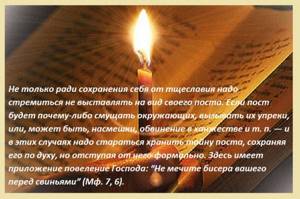
8. Follow Jesus . Christ's stay in the desert is an example to follow. He showed us all how strong His faith and convictions are. He was not tempted by the devil, he did not betray the Almighty. That is why fasting before Easter is a test of our soul with trials. Only complete humility and faith in salvation will help our soul on the path to the Kingdom of Heaven.
Sample Lenten menu for every day
Dry eating days
Breakfast
1st option:
- 1 banana;
- A piece of bread with fruit jam or honey;
- Tea.
Option 2:
- Small bowl of muesli, soaked in water;
- Fruit salad (simply chopped and mixed fruits - apples, bananas, berries, etc., depending on the season and your ability to buy fruit at the market or in a store)
- Tea or coffee without milk
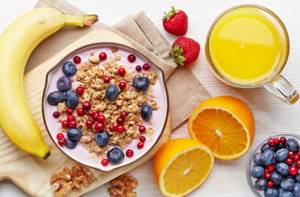
Dinner
- Vegetable salad without oil, for example:
- lettuce, tomatoes, cucumbers, radishes, onions, bell peppers - salt, pepper, mix, and you're done;
- or fresh cabbage, carrots, squeeze a little lemon juice, add salt, mash a little, mix - you can serve;
- You can add seeds, chopped nuts or crackers to salads if you like.
- For dessert - a small piece of bread or crackers with honey;
- Tea or compote.
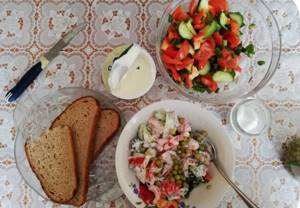
Dinner
- Let's not overeat and eat a handful of nuts for dinner (walnuts, hazelnuts, pistachios, cashews, peanuts, etc.).
- One or two apples
- Compote or juice
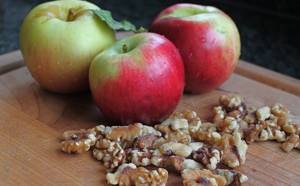
In principle, if you look at 2-3 similar menu options for the strictest fast days (without the possibility of preparing hot food), then everything seems not so scary. Moreover, your decision to fast was voluntary and deliberate.
Hot food days without oil
Breakfast
- Porridge from any cereal (buckwheat, oatmeal, millet, semolina) in water (add a little sugar for taste);
- Tea, juice or compote.
Dinner
- Lenten vegetable or mushroom soup, cabbage soup or borscht (without frying);
- Slice of bread;
- Compote.
Dinner
- Stewed vegetables (for example, zucchini, eggplant, cabbage, or any others, you can add mushrooms and some potatoes);
- Or a vegetable casserole - finely chop different vegetables (according to your taste), season, lay in layers, bake in the oven for 30-40 minutes at a temperature of 150-180 degrees.
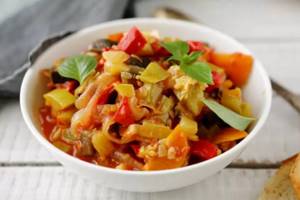
Hot Butter Days
In principle, you can cook the same dishes as in the days of hot food without oil, only you can experiment and cook almost the same thing, but with oil. For example, add frying to a lean soup, and fry potatoes with mushrooms or vegetable cutlets for dinner. Or also stew vegetables, but with the addition of fried onions. The taste of cooked dishes will be more pronounced and interesting, and weekends, even during fasting, will seem not so fast.
In general, expand the boundaries of your imagination, experiment, create your own Lenten menu options for Lent every day. Despite the fact that fasting correctly means being able to deny yourself certain temptations, do not forget that a nutritious and varied diet is a very important factor for your health.
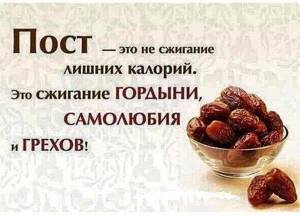
And of course, do not forget that fasting correctly means not only following the rules of fast food, but also remembering your spirit - not overindulging not only in food, but also in worldly entertainment, devoting time to prayer and pacifying yourself if you suddenly I wanted to quarrel with someone, or I just felt angry or irritated with another person.
So, we talked to you about Lent 2020 and the Lenten menu for every day. We wish you all the best, peace in your soul, happiness and prosperity in your family, as well as successful preparations for the holiday of Great Easter!
Similar
What not to eat during Lent
Lenten abstinence involves giving up certain foods that we eat every day. This instruction is given by the church and Holy Scripture. Strongly religious people watch themselves most strictly in monasteries and churches. If for the former this is a law that is violated extremely rarely and has a good reason for this, then for the latter the permission of the holy father is needed. After all, such severity is not just a feat, it is a comparison, a direct follow-up to the 40 days of Jesus’ sojourn in the desert.
For the entire Orthodox world, the exceptions will be:
Great Lent meals by week and day
To make it easy to enter a long fast, the church established a period for preparing the body. On the days of Wednesday, Monday, and Friday during these weeks, it was necessary to give up meat dishes; everything lean was included in the diet.
The fasting period begins on the strictest day - the 1st. This day is marked as the cleanest. It is on the 1st that you need to put things in order in the house and sort out your thoughts. Cleaning is preceded by a morning service. If you can’t get to it, try to defend the evening one on the 29th, especially since it is no less important . They spend the whole day on nothing but water, without even eating a crust of bread.
What dishes are prepared during Lent, you can see Lenten recipes here. Guided by the Lenten menu provided below, you will always have the necessary information and cook without violating the rules of Lent.
first week of Lent, menu by day
The first seven days are very important and strict. Anyone who observes strictness during these days can spend the following weeks relaxing. The exception is the last seven days before Easter.
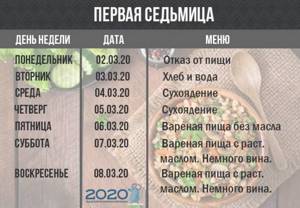
second week of Lent, menu by day
Starting from Monday of this week you can cook. Cooking is carried out without fanaticism, the number of dishes should be such that you and your family are full, but not overeat. You can prepare hearty salads for breakfast, lunch must include the first thing, and light food for dinner. Drink plenty of fluids throughout the day.
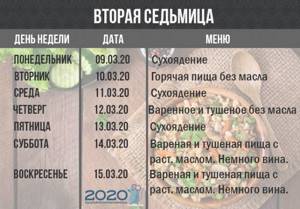
third week of Lent, menu by day
This is a special week. Services at the Abode of the Lord are held with a small procession of the Cross from the altar. It is necessary to bow to the cross. During the week, meals are reduced. You can cook many different dishes and drink some wine on the weekend.
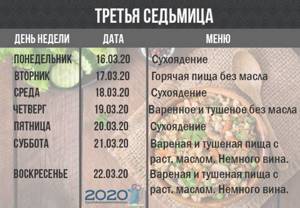
fourth week of Lent, menu by day
During this period, the rule of the previous two weeks continues. On weekends the menu is more extensive. To celebrate the Annunciation of the Lord, you can serve fish dishes and wine. Wine is for the sake of relaxing the body, but not for the sake of drunkenness; more than a glass is not allowed.
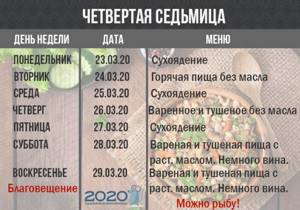
The future Mother of God received the good news; the angels told her about the birth of a new life. The Lord made her happy by giving her, the righteous woman, His Son. It is He who is destined to become the King on a sinful earth, to save the world from fornication, to return people to faith, to die a terrible death for them.
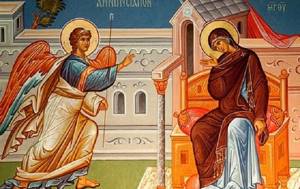
The week is dedicated to St. John. He spent his entire life as a hermit, sharing the Word of God. The smartest book was written with his hand, which is re-read with trepidation even today.

fifth week of Lent, menu by day
Nutrition in the fifth week is no different from the previous three. Dry food is replaced by cooked food. The main thing is no fat, including vegetable fat. Closer to the weekend, you can diversify the menu with lean but tasty dishes, and even drink a little wine.
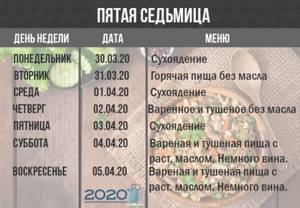
sixth week of Lent, menu by day
The penultimate week is similar to the fifth, dry food is replaced by very lean dishes. On weekends, you are allowed to add oils, serve fish dishes, and drink a little wine.
Nutrition rules during fasting
If everything is more or less clear with the general aspects of organizing fasting, then with the specific practice of preparing a diet, difficulties always arise.
Important! The main mistake of any fast is to constantly think about food.
Eating on fasting days should bring relief to the body, so overeating should be avoided. An excess of even light plant foods can negatively affect the digestive system and overall well-being.
A properly and competently organized Lenten menu will not only not cause any harm to the body, but, on the contrary, will help improve your health. Since the usual daily diet of most people is far from healthy, food restrictions are good in that a person begins to think about what he is eating.
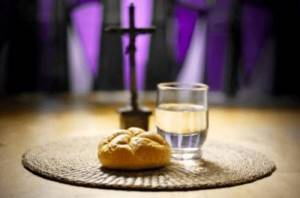
Lent is considered one of the most important to observe
An additional effect when observing restrictive days, along with refusing animal foods, is often the exclusion of harmful foods - mayonnaise, processed foods, unhealthy fats.
Along with the obvious benefits of switching to lighter foods, a lean diet may have deficiencies in certain nutrients. Let's look at the main problems of creating a Lenten menu and ways to solve them.
Advice! Let us emphasize once again that attention should not be paid to nutrition first. Retreat is a time of spiritual activity, prayer, and struggle with one’s sins.
Protein deficiency
If we consider the nutritional side of fasting, the most noticeable shift in the diet will be a significant lack of protein. With a normal diet, we get protein from meat, eggs, dairy products - these are the ones that have to be excluded from the diet for a while.
Protein is an essential building block for the cells of the human body. It takes part in basic biochemical reactions. Its acute and long-term deficiency can have an extremely negative impact on a person’s health.
Orthodox fasts, despite all their severity, do not last so long as to significantly deplete protein reserves in the body of a healthy person. In order to saturate your body with this essential nutrient, you need to include vegetable protein in your Lenten menu. It is found in the following products:
- soy, soy meat;
- nuts:
- beans, beans, chickpeas;
- mushrooms;
- cereals
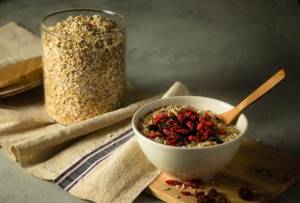
Nuts, soy, legumes and cereals will help fill the protein gap
By constantly using these products to prepare lean dishes, you can easily do without meat and dairy products for a long time.
Excess carbohydrates
In our latitudes, the exclusion of animal foods most often begins to be replaced by foods high in carbohydrates - bread, lean pastries, potatoes. Excess carbohydrates in the diet not only provokes digestive problems, but can also lead to excessive weight gain. In order to avoid such problems, you need to ensure there is a sufficient amount of vegetables, fruits and herbs in the menu. It is advisable to eat as often as possible:
- vegetable and fruit salads;
- vegetable soups, borscht;
- use fresh herbs wherever appropriate.
In addition, what kind of carbohydrates we eat is important. They are also important sources of nutrients and should not be completely eliminated. But it is desirable that the main part of them be represented by so-called long or slow carbohydrates.
They are distinguished by the fact that they take longer to digest, give a long-lasting feeling of fullness, do not provoke sudden jumps in blood sugar levels, and are not stored in fat tissue reserves.
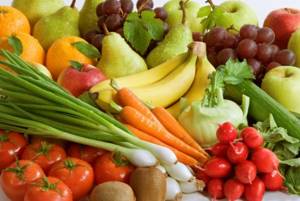
Vegetables and fruits will help diversify the Lenten menu
Slow carbohydrates include:
- minimally processed grains (brown rice, buckwheat, pearl barley, whole oatmeal and others);
- durum wheat pasta (durum);
- baked goods made from whole grain flour.
It is advisable to give preference to dishes made from these products on fasting days. In combination with a large amount of vegetables, such a diet will saturate the body for a long time and replenish it with all the essential nutrients.
Fat imbalance
The third most important nutrient, along with proteins and carbohydrates, is fat. In a normal diet, we get a large amount of them from food of animal origin. By eliminating it, we can get an acute lack of fat, which will be expressed in increased fatigue, poor condition of the skin, hair and nails, and increased irritability.
In order to avoid a lack of fat, you need to enrich your diet with healthy vegetable fats. To do this, the menu should include:
- vegetable oils, mostly unrefined (sunflower, olive, corn, coconut, flaxseed);
- nuts;
- avocado;
- olives, black olives;
- sunflower seeds, pumpkin seeds.
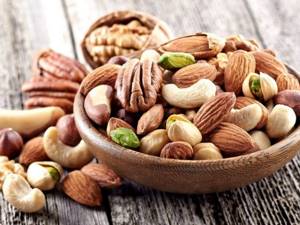
The lack of fat during Lent can be compensated by nuts
It is not advisable to heat unrefined oils (except coconut oil), so it is better to use them for dressing salads and adding them to ready-made dishes after cooking. For frying, it is better to use refined oils - for example, olive oil.
Vitamin deficiency
Another disadvantage, which is often attributed to the Lenten menu, is considered to be an acute lack of vitamins and minerals. Indeed, if you eat only oatmeal with water and dry bread for several weeks, such a diet can hardly be called healthy.
Even a fairly strict fast, observing the days of dry eating and other requirements of the Charter, can be diversified with healthy foods. In order to enrich the Lenten table with vitamins and microelements, use the following products:
- seasonal fresh vegetables and fruits;
- dried fruits (dates, dried apricots, prunes, raisins, figs);
- fresh herbs;
When does Lent 2020 end?
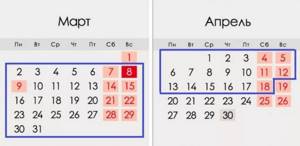
Let's summarize:
Fasting is given to a person as a test; it is a kind of test of faith by temptation. A person who firmly believes in Christ will never deviate from the right path and will stand in any post without breaking the rules. Our recommendations will help you understand yourself and come to the temple of God. Confession and Holy Communion are tools that will help not only with fasting. They make us cleaner, brighter, bring us closer to God.
If you doubt your own abilities, you are tormented by prejudices, doubts creep in, talk to a priest. This is a servant of God, who is destined to be a listener, a mediator between you and the Almighty, he does not condemn, since he has no right to do so. Don’t be afraid, tell him about your difficulties, he will tell you what to do. The same applies to fasting, with it you will select the measure that you can carry through all the blessed 48 days.
May the Almighty bless you for fasting, cleanse your soul, relieve you of doubts, give you strength, humility, and patience.
Holidays
There are three main holidays in Lent: Lazarus Saturday (April 23), Palm Sunday (April 24) and the Annunciation (April 7). On Lazarev Saturday you can eat dishes with fish caviar, on Verbnoye - fish. Fish is also allowed on Annunciation Day. Also on holidays you can drink wine and flavor your food with vegetable oil.
In addition, on Thursday of the fifth week of Lent (April 14) on Mariino standing, it is allowed to add vegetable oil to hot dishes.
Important! On holidays you can drink wine, but only to maintain strength - one glass of red.
